Header logo
header top contact widget
Dentures/Partial Dentures
The Mirror Image Of Dental Implants
Posted on Sep 16, 2024 by William J. Claiborne, DDS MS
A study conducted in the United Kingdom in 2015 revealed that men check out their reflection 23 times a day while women do about 16 times. While other studies dispute the gender disparity (such as women using the mirror 34 times a day on average), all adults use the mirror more often than is probably perceived.
https://www.reuters.com/article/world/us/women-seen-checking-mirror-every-half-hour-idUSL05402197/
Naturally, part of that time in the mirror is spent each morning or evening as people prepare for the day and then get ready for bed. Ideally, several minutes of this time is being devoted to brushing and flossing. But, are they really getting a good look inside their mouths?
Typically, people don’t think all that often about the presence of their teeth, unless something hurts. Certainly, when hot or cold causes a sharp “jolt” of pain or a constant ache occurs around a particular tooth, an individual realizes something needs attention. After all, there is rarely pain in the mouth that is going to repair on its own. And, pain is our brain’s way of getting our immediate attention that something is wrong.
Adult tooth loss is fairly common in the U.S. Accidents, tooth (or tooth root) fractures, decay and certain health conditions can increase one’s potential for losing natural teeth. However, periodontal (gum) disease is the most common.
It is estimated that nearly half of the adult population have some form of periodontal disease (47.3%). Symptoms may include:
• tender and swollen gums that bleed easily when brushing
• persistent bad breath
• gums that are red in color rather than a healthy pink
• gums that recede from the base of teeth
• pus pockets around teeth as bacterial accumulate
• gums that are a spongy texture
• teeth that shift or loosen
According to the Centers for Disease Control & Prevention (CDC), over one-fourth (26%) of American adults ages 65 and older have 8 or less natural teeth. The CDC equates this number (having 8 or fewer teeth) as “severe tooth loss” since it impacts an individual’s ability to thoroughly eat a healthy diet.
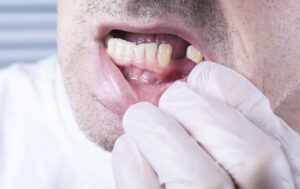 While losing a tooth during a lifetime seems “normal,” any loss of an adult tooth should be a wake-up call. As an Asheville periodontist, I know that losing a natural tooth can set into motion a snowball effect. And, it’s what occurs below the gums that creates the path that, for many older adults, leads to dentures.
While losing a tooth during a lifetime seems “normal,” any loss of an adult tooth should be a wake-up call. As an Asheville periodontist, I know that losing a natural tooth can set into motion a snowball effect. And, it’s what occurs below the gums that creates the path that, for many older adults, leads to dentures.
The absence of a tooth root in the upper or lower jaw bone is a loss of stimulation to the bone mass where it was once positioned. These roots provide both stimulation and nourishment that enables the bone to maintain a healthy mass. Without the presence of tooth roots, the bone begins to “melt away” in a process known as resorption.
It is commonly known that muscles, not used, will shrink in mass. When the jaw bones are lacking stimulation by the tooth roots they’re designed to hold, bone mass begins to shrink.
Resorption begins shortly after the tooth’s root is removed. Once it starts, it continues at an ever-increasing pace. For example, the first year after a tooth root is missing, bone decline may be minimal. With each passing year, however, the pace of bone loss accelerates.
As the bone shrinks in height, natural tooth roots adjacent to the area of missing teeth are subject to movement and root damage. On average, the next teeth you’re most likely to lose are the ones bordering areas of missing teeth.
How do you halt the process of tooth loss due to bone resorption?
Because dental implants replace the tooth above the gum line AND the root portion below it, the bone is able to retain its mass. Using the sturdy foundation of the jaw bone, dental implants are able to restore the look, feel and chewing stability like that of natural teeth.
A periodontist has advanced training to properly diagnose and treat all stages of periodontal (gum) disease (including gingivitis and periodontitis) as well as placement of dental implants. Because we understand the issues that occur above and below the gums, we are proponents of replacing teeth with dental implants, for a wide number of reasons.
1. Dental implants help to prevent declining mass of the jaw bone. In addition to problems associated with dental prosthetics (dentures, partials) when it comes to biting and chewing, bone loss causes changes in facial appearance that are aging far beyond one’s actual years. An implant restores stimulation to the bone and halts the progress of bone loss.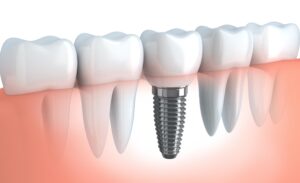
2. Dental implants have one of the highest success rates of any in-bone implant in the body, including hips and knees. When properly selected, placed and maintained, they are designed to last your lifetime.
3. Unlike crown-&-bridge combinations or partials, dental implants do not rely on neighboring teeth for support by adjacent teeth. And, because they help to preserve the bone that supports neighboring teeth, they are actually beneficial to the life of other natural teeth.
4. Dental implants are a one-time expense. They do not decay, require root canals, crack or break, future expense for upkeep or repairs is not needed. The material they are made of (titanium) biologically integrates with living bone and is not rejected nor will it cause adverse reactions to surrounding structures. With proper care, they will last throughout your life.
5. Because dental implants are supported by the upper or lower jaw bone, just as natural tooth roots, they are able to restore biting strength and chewing stability. After an implant is placed in the bone, the bone grows around it to fully secure it in the jaw. This enables confident biting and chewing without fear of movement that is possible with a denture or partial.
Like anything that is implanted into your body, dental implants should be placed in the hands of an experienced specialist. Ideal diagnosis is important, and can even save the patient in overall treatment costs. For example, when missing more than one tooth in one area, one implant can often hold two or a bridge of teeth. Several strategically-placed implants may also be used to support a full arch of teeth.
Proper placement and support in caring for implants is an important part of a successful outcome. However, dental implants can fail. A periodontal specialist can be an asset to your investment. When dental implants are chosen and placed by a periodontist, he or she is trained to select the one that will work best for you now and throughout your lifetime.
In addition to our specialized skills, our Asheville periodontal dental office provides advanced technology and a compassionate approach to care so you can enjoy a comfortable, efficient experience that allows you to have optimal success. Some of this technology is specific to dental implants, including: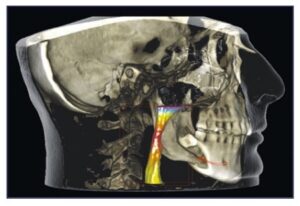
• LANAP With PerioLase MVP 7 – Laser-Assisted New Attachment Procedure is an advanced protocol that efficiently and effectively treats advanced gum disease with the added advantages of a dental laser. For patients who are preparing for dental implant placement, resolving gum disease prior to treatment is mandatory. LANAP offers a non-surgical alternative for patients with moderate to severe periodontal disease with very little discomfort and a quick recovery time.
• Cone Beam Imaging – These provide 3D images that are ideal for diagnosing and treatment planning. The highly-detailed images show sagittal, axial, and coronal planes, which locates and tracks nerve canals to optimize implant placement.
• Computerized Dental Implant Placement – This system provides the futuristic ability to position dental implants before the process actually begins. Through computerized technology, the implants are selected and “ideally positioned” on a 3D model of the patient’s jaw. From this, a template is developed for optimal treatment success, even for complex cases.
• CS 3600 Intraoral Scanner – Rather than make impressions with bulky, goopy trays, this scanner quickly and comfortably captures digital impressions accurately and easily. These are used to create precision models or appliances (dental implant crowns, bridges, or full arches). The scanner can also reach hard–to–access areas in the patient’s mouth for superior results with improved patient comfort.
For individuals who have lost teeth because dental fear or anxiety kept them from receiving regular dental care, we are especially sensitive to the concerns of these patients. Our entire team is committed to optimal patient comfort at every visit. Additionally, we offer:
• Oral sedation is a pill that helps patients relax. It also has an amnesiac effect, leaving most with little or no memory of treatment afterward.
• I.V. sedation (also known as “twilight sleep”) places the patient in a deeper sleep state and erases memory of the procedure. It is administered by a Medical Doctor (MD) who is a board certified Anesthesiologist.
For those who feel dental implants are out of reach financially, we encourage them to have a consultation to see exactly what their options may be and the treatment fees entailed. We offer several excellent payment plans, some with no down payment and no interest charged when paid according to the terms.
If you are considering dental implants, you may wish to begin with a consultation appointment. During this time, we can explain the vast difference in comfort, treatment time, and success available through our specialized skills and extensive technology.
Call 828-274-9440 to schedule. New patients are always welcome and a referral is not always required.
Don’t Let Tooth Loss Make You LOOK or FEEL Old.
Posted on Aug 26, 2024 by William J. Claiborne, DDS MS
I have never imagined how old I could look until the first timerI saw my image on FaceTime. It reminded me of a time I unexpectedly passed by a mirror and saw an old man looking at me, which of course was my reflection.
Aging is tough enough without looking or feeling old. While adults have gotten better at staying more active and eating better diets than some previous generations, having an aged appearance beyond one’s actual years is a downer.
Something people often do not factor into the telltale signs of aging is bone loss. Generally, people acknowledge that they’ll lose some height with age as the skeleton submits to typical bone loss. However, bone loss due to missing natural teeth isn’t typically perceived as part of the process.
Yet, losing bone mass in the jaws can greatly affect one’s appearance, regardless of their actual years. This is due to the lack of stimulation provided to the jaws that natural tooth roots once provided.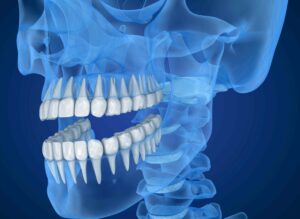
Your natural teeth are supported by your upper and lower jaw bone, known respectfully as the maxilla and mandible. These strong, study bones support tooth roots securely.
When a natural tooth is removed, its absence causes a reaction below the gum line. This is through a process known as “resorption.” Without tooth roots present in the bone, the stimulation and nourishment needed for the bone to maintain a healthy mass is removed. Thus, the bone begins to decline.
As it shrinks in height, the adjacent teeth are more vulnerable to loss. Statistics show that teeth adjacent to areas where natural teeth are missing will be the most likely to be lost next.
Resorption begins shortly after the tooth root is removed. Once it starts, it continues at an ever-increasing rate year after year. For example, the first year after a tooth root is absent, the loss of bone may be minimal, probably unnoticeable. With each passing year, however, the pace of loss accelerates.
Over time, resorption’s effects become visible. As the bones decline in mass, deep wrinkles form around the mouth. The corners of the mouth turn downward. The chin takes on a more pointed shape and the mouth sinks into the face. The nose seems to get closer to the chin as the jaw bones thin. Jowls form as facial muscles detach from shrinking bone structure.
For people who wear a denture or partial, the pressure of wearing these appliances can speed up the rate of bone loss. For those who sleep in their denture, the 24/7 pressure speeds this pace even further. Even people who have a “bridge” may start to notice a space between the bridge and the gums, one that was probably not obvious before.
As a periodontist, I specialize in the prevention, diagnosis, and treatment of all stages of periodontal (gum) disease. In addition, periodontists are particularly skilled in performing cosmetic periodontal procedures. I also have advanced training and skills in the selection and placement of dental implants.
When it comes to replacing natural teeth, dental implants are the ideal for many reasons. When it comes to halting bone loss, they are able to restore stimulation to the jaw bone. Additionally, dental implants restore the ability to eat with stability, chew comfortably, and laugh and speak with confidence. Dental implants do not decay and will never need root canals.
There are over 40 different implant systems, each designed to accommodate various needs and goals. Obviously, a strong consideration in determining which type of dental implant is recommended is in the amount of jaw bone mass present.
An implant needs a particular amount of bone structure to support it. Depending on the amount of bone present to support the implant(s), the choice of which implant system to recommend can be made.
For some, we may recommend a bone rebuilding process prior to implant placement. Or, we may advise an implant that uses unique implant lengths and placement angles (the “All-On-4”) that can overcome the challenges of bone loss.
While there are also many considerations in selecting the right type of dental implant, the final choice, of course, is the patient’s preference. Does he or she want an implant that is non-removable (“fixed”)? Is cost the determining factor? Does the patient need just one implant or several? Can one implant dependably support a “bridge” of teeth in one area?
All in all, however, dental implants are an excellent choice for replacing teeth. Implants have an extremely high success rate, higher than any implant-in-bone option. And, dental implants are designed to last a lifetime. With proper selection and maintenance, they will never need replacing or repair.
Our Asheville periodontal practice is known for its priority on comfort and providing respectful care. With over 70% of the adult population having some level of dental fear or anxiety, we have a long-standing reputation for compassion and understanding.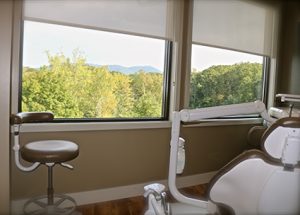
For optimal comfort and relaxation, we offer several sedation options, including oral and IV sedation. With both sedation options, patients are closely monitored with advanced safety equipment throughout treatment.
• Oral sedation is a pill that helps patients relax. It also has an amnesiac effect, leaving most with little or no memory of treatment afterward.
• I.V. sedation (“twilight sleep“) places the patient in a deeper sleep state and erases memory of the procedure. It is administered by a Medical Doctor (MD) who is a board certified Anesthesiologist.
Ideal diagnosis is another important aspect of care here, which can save the patient much in overall treatment costs. For example, when missing more than one tooth in one area, one implant can often hold two or a bridge of teeth. Several strategically placed implants may also be used to support a full arch of teeth.
To support diagnostics in our Western NC periodontal dental office, we feature some of the region’s most advanced technology in the industry, including Cone Beam 3D imaging and laser dentistry. Our dental implant patients also have the advantages of technology that can minimize treatment speed healing and enhance comfort, thanks to Simplant.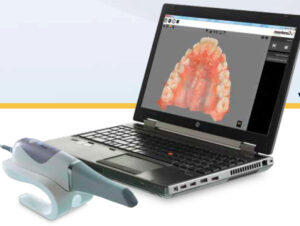
With the support of Simplant computerized dental implant placement, we can actually position the implants on the computer using a 3D model of the patient’s jaw pre-surgically. This aids in the selection of the implant type that ensures a precision fit.
For individuals who have lost a great deal of bone and need bone rebuilding procedures prior to placement, we are highly skilled in the procedures of bone grafting. However, in many cases, we are able to apply bone generation material to the area that is less involved than the grafting process.
We believe that proper placement and support in caring for implants is an important part of a successful outcome. However, dental implants can fail. This is why a periodontal specialist can be an asset to your investment. When dental implants are chosen and placed by a periodontist, he or she can select the one that will work best for you now and throughout your lifetime.
In our Asheville periodontal dental office, we combine technology with our advanced skills and compassionate approach to care so you can enjoy a comfortable, efficient experience that allows you to have optimal success.
Call 828-274-9440 to arrange a consultation. During this time, we can discuss treatment that can achieve your needs and goals as well as the process and anticipated costs. If interested, we will also explain payment plans, some that are interest free and require no down payment.
Dental Implants Done To Perfection!
Posted on Jul 23, 2024 by William J. Claiborne, DDS MS
In our Western NC periodontal dental office, we see many patients who are contemplating tooth replacement through dental implants. This can be a complex decision, as today’s implant dentistry offers many choices that are important to achieving a desirable outcome.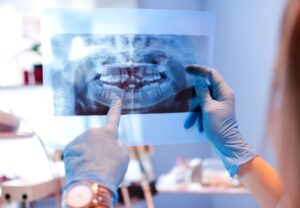
This is why accurate, personalized information is best left to a credible, knowledgable source. As a periodontal dental specialist for over 30 years, I have advanced training in all types of dental implants as well as the procedures that may be needed to ensure your investment brings lasting satisfaction.
Over the years, I’ve found that many patients have misconceptions when it comes to dental implants. My desire is to help to dispel the incorrect information so each individual understands the realities when it comes to dental implants.
There are over 40 different implant systems, each designed to accommodate various needs and goals. For example, one consideration in determining which type of dental implant is recommended is in the amount of jaw bone mass.
An implant needs a particular amount of bone structure to support it. After several years of missing tooth roots, the bone begins to decline in mass. For people who wear a denture or partial, the pressure of wearing these appliances can actually speed up the rate bone loss.
So, depending on the amount of bone present to support the implant(s), the choice of which implant system to recommend can be made. For some, we may recommend a bone rebuilding process prior to implant placement. Or, we may advise an implant that uses unique implant lengths and placement angles (the “All-On-4”) that can overcome the challenges of bone loss.
There are also many considerations in selecting the right type of dental implant. The final choice, of course, is the patient’s preference. Does he or she want an implant that is non-removable (“fixed”)? Is cost the determining factor? Does the patient need just one implant or several? Can one implant support a “bridge” of teeth in one area? And so on.
These are just some of the factors we take into consideration when discussing dental implants with patients. It is in our experienced, skilled hands that we recommend one system over another. What’s online or from opinions of others may create confusion and even dissuade you from pursing this ideal option to replace missing teeth.
One misconception is that dental implants are more expensive than other tooth replacement options (dentures, partials, crown-&-bridge). However, they are actually a bargain when all areas are considered. Dental implants do not rely on the support of neighboring teeth. This means that crowning otherwise healthy, natural teeth is not necessary.
The investment made in dental implants is a wise one. Dental implants have one of the highest of all success rates of any implant-in-bone procedure (such as hips, knees), up to 98 percent. Made of titanium, this metal successfully bonds with living bone. This means the bone will grow around your implant(s), integrating it into your bone mass to restore dependability and stability.
Being implanted into the jaw bone, dental implants also restore stimulation that reduces risks for further bone loss. This halts bone shrinkage so you avoid problems associated with resorption. These include an aged facial appearance (such as deep wrinkles around the mouth and formation of jowls), a weakened jaw bone, and the higher risks for continued tooth loss.
Some people also assume that an implant is needed for each missing tooth. That’s not the case for many of our implant patients. The implanted portion of a dental implant can often support two teeth or a bridge of several teeth. When 4 – 8 implants are strategically placed, they may be able to support a full arch of teeth, which often includes non-removable types.
To optimize dental implant success, we have specialized skills to incorporate the more-complex procedures involved in implant placement. For example, a periodontist can incorporate bone rebuilding procedures into treatment to a proper depth. This specialist can also help to restore bone that has occurred in the mandible (lower jaw) or maxilla (upper jaw), which may also require a sinus lift.
In our Asheville periodontal dental office, we offer implant diagnosis (using the benefits of advanced technology) for placement with the pre surgical advantages of achieving optimal oral health. Here, we feature some of the most advanced imaging and computerized technology available in the industry. Those specific to dental implant diagnosis and placement include:
LANAP Protocol Using PerioLase MVP-7: Efficiently and effectively treats periodontitis (advanced gum disease) with laser technology. It causes very little discomfort and has a quick recovery time. This has also been found to stimulate bone regrowth in damaged areas.
Dental Radiology With 3-D Cone Beam Technology: This imaging is ideal for diagnosis and treatment planning. The imaging covers the entire dentition area with clear views of the mandible and maxilla (upper and lower jaw).
Simplant Dental Software for Computerized Dental Implant Placement: This system helps in pre-surgical positioning of dental implants on the computer, using a 3D model of the patient’s jaw. This aids in the selection of the implant type that ensures a precision fit.
These technologies help to optimize patient comfort and treatment success as well as minimize treatment, meaning that patients are never over-treated. Too, healing time is typically reduced, thanks to these specialized measures.
Additionally, we make patient comfort a high priority. We are known for making patient comfort a high priority in all procedures. In addition to many measures of creating a comfortable visit, we offer Oral and IV sedation (“twilight sleep”). Both are safely administered by highly qualified medical professionals who use advanced safety monitoring equipment.
Dental implants are the next best thing to natural teeth. They feel like “real” teeth, look beautiful, and restore a confident, comfortable ability to bite and chew. If you have thought about replacing missing teeth or are frustrated with a denture or partial, call 828-274-9440 to arrange an appointment.
When it comes to your smile, be an informed consumer and avoid hype or misguidance. In one visit, I feel we can help you understand how the selection of a periodontist can be your first step in a successful outcome and a smile you’ll love to share!
Dental Implants Gaining Ground In Tooth Replacement Preferences
Posted on Jun 20, 2024 by William J. Claiborne, DDS MS
For adults who have lost natural teeth, I have good news and bad news. Let’s get the bad news out of the way first…
Missing natural teeth, whether replaced by a full denture, partial denture, bridge, or not being replaced at all, can lead to problems that impact your oral health, even the lifespan of remaining natural teeth. I’ll address those problems further on, but let’s move on to some good news.
According to the National Institutes of Health & Nutrition Examination, by 2026 nearly 23% of adults are estimated to opt for dental implants as their choice to replace teeth.
https://www.ncbi.nlm.nih.gov/pmc/articles/PMC6854267/
This is great news for our rapidly aging population. Dental implants come with a number of advantages that effect overall health. These include:
• The ability to bite and chew food thoroughly, aiding digestion. It has been found that people who wear dentures take more medications and have more gastro-intestinal problems.
• Eating comfort so a diet of fibrous and healthy food choices can provide sufficient vitamins, minerals and protein.
• Confidence in social situations, which (according to an article by the Mayo Clinic News Report): “Socializing not only staves off feelings of loneliness, but also it helps sharpen memory and cognitive skills, increases your sense of happiness and well-being, and may even help you live longer.”
• Helping to support remaining natural teeth by preserving jaw bone mass. When a tooth root is removed from the jaw bone where it was once supported, a process known as resorption begins. Once underway, it continues at an ever-increasing pace, accelerating with each passing year. As the bone shrinks, adjacent teeth are subject to movement and root damage. On average, the next teeth you’ll most likely lose are those bordering areas of missing teeth.
Since the mid to late-60’s, dental implants have been fine-tuned and perfected. Today, there are nearly 40 different types of dental implants. These systems are designed to accommodate specific needs and goals.
For instance, using just 4 or 6 implants placed at unique angles, the All on 4 Dental Implant system is able to evenly distribute the forces of biting and chewing in minimal bone. This is ideal for people who have experienced severe bone loss, helping them avoid the need for bone rebuilding procedures.
With all the great reasons to replace missing teeth with dental implants, an important decision in having a successful outcome is in who places your implants.
Although some generalists take courses in dental implant placement, many of these are offered by the manufacturers of particular implant systems. Thus, these courses primarily focus on the implant available through this one company, which may not be the most ideal choice for your specific needs.
This is why many dentists refer the placement portion of implants to a periodontal specialist. A periodontist has advanced training and skills in the diagnosis and placement of all types of dental implants. This means that this dental specialist can determine which implant system will work best for your individual needs.
Another benefit of a periodontist’s skills for implant patients is in their ability to conduct additional procedures, such as a sinus lift, needed in treatment. This ensures the patient’s implant(s) are positioned in the proper bone mass at a healthy depth so it does not pose risks to surrounding structures.
As a specialist in treating all stages of gum disease, a periodontist is also able to help optimize your gum health prior to implant placement. By pretreating any periodontal inflammation, the implant has a healthy foundation from the very beginning.
In our Western NC periodontal dental office, we incorporate the advantages of some of the most advanced technology in dentistry; many of these options which are not readily available in other dental offices in our region. These computerized marvels offer advantages to patients in helping to minimize treatment needs, speed healing, and optimize comfort.
These include laser dentistry, Cone Beam imaging, Cone Beam computerized tomography imaging, intraoral scanning, and computerized dental implant placement.
Additionally, in our Asheville periodontal dental office, we offer oral and IV sedation (“twilight sleep”) for optimal comfort. Both have an amnesiac effect, leaving most with little or no memory of treatment afterward. Here, anesthesia is overseen by a Medical Doctor (MD) who is a board certified Anesthesiologist. With both sedation options, patients are closely monitored with advanced safety equipment throughout treatment.
If you’ve considered dental implants, take the first step to a new you today! Begin by calling our Asheville periodontal dental office to speak with a friendly staff member at: 828-274-9440.
If the cost of dental implants has prevented you from choosing this optimal tooth replacement option, most of our payment plans require no down payment, are interest-free, and have no prepayment penalty. Feel free to ask about those during a consultation.
Recent Posts
Categories
Archives
- September 2024
- August 2024
- July 2024
- June 2024
- May 2024
- April 2024
- March 2024
- February 2024
- January 2024
- December 2023
- November 2023
- October 2023
- September 2023
- August 2023
- July 2023
- June 2023
- May 2023
- April 2023
- March 2023
- February 2023
- January 2023
- December 2022
- November 2022
- October 2022
- September 2022
- August 2022
- July 2022
- June 2022
- May 2022
- April 2022
- March 2022
- February 2022
- January 2022
- December 2021
- November 2021
- October 2021
- September 2021
- August 2021
- July 2021
- June 2021
- May 2021
- April 2021
- March 2021
- February 2021
- January 2021
- December 2020
- November 2020
- October 2020
- September 2020
- August 2020
- July 2020
- June 2020
- May 2020
- April 2020
- March 2020
- February 2020
- January 2020
- December 2019
- November 2019
- October 2019
- September 2019
- August 2019
- July 2019
- June 2019
- May 2019
- April 2019
- March 2019
- February 2019
- January 2019
- December 2018
- November 2018
- October 2018
- September 2018
- August 2018
- July 2018
- June 2018
- May 2018
- April 2018
- March 2018
- February 2018
- January 2018
- December 2017
- November 2017
- October 2017
- September 2017
- August 2017
- July 2017
- June 2017
- May 2017
- April 2017
- March 2017
- February 2017
- January 2017
- December 2016
- November 2016
- October 2016
- September 2016
- August 2016
- July 2016
- June 2016
- May 2016
- April 2016
- March 2016
- February 2016
- January 2016
- December 2015
- November 2015
- October 2015
- September 2015
- August 2015
- July 2015
- June 2015
- May 2015
- April 2015
- March 2015
- February 2015
- January 2015
- December 2014
- November 2014
- October 2014
- September 2014
- August 2014
- July 2014
- June 2014
- May 2014
- April 2014
- March 2014
- February 2014
- January 2014
- December 2013
- November 2013
- October 2013
- September 2013
- August 2013
- July 2013
- June 2013
- May 2013
- April 2013
- March 2013
- February 2013
- January 2013
- December 2012
- November 2012
- October 2012
- September 2012
- August 2012
- July 2012
- June 2012


